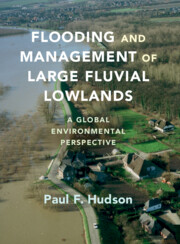Book contents
- Flooding and Management of Large Fluvial Lowlands
- Flooding and Management of Large Fluvial Lowlands
- Copyright page
- Dedication
- Contents
- Figures
- Tables
- Preface and Acknowledgments
- 1 Fluvial Lowlands and the Environment
- 2 Rivers and Landscapes
- 3 Hydrologic and Geomorphic Processes in Fluvial Lowlands and Deltas
- 4 Dams, Rivers, and the Environment
- 5 Hydraulic Engineering for Channel Stability and Flood Control
- 6 Dikes and Floodplains
- 7 Flood Basins and Deltas
- 8 Toward Integrated Management of Lowland Rivers
- 9 Lessons Learned
- Bibliography
- Index
8 - Toward Integrated Management of Lowland Rivers
Published online by Cambridge University Press: 04 November 2021
- Flooding and Management of Large Fluvial Lowlands
- Flooding and Management of Large Fluvial Lowlands
- Copyright page
- Dedication
- Contents
- Figures
- Tables
- Preface and Acknowledgments
- 1 Fluvial Lowlands and the Environment
- 2 Rivers and Landscapes
- 3 Hydrologic and Geomorphic Processes in Fluvial Lowlands and Deltas
- 4 Dams, Rivers, and the Environment
- 5 Hydraulic Engineering for Channel Stability and Flood Control
- 6 Dikes and Floodplains
- 7 Flood Basins and Deltas
- 8 Toward Integrated Management of Lowland Rivers
- 9 Lessons Learned
- Bibliography
- Index
Summary
This chapter examines modern approaches to river management as an alternative to traditional hard engineering that disconnected rivers from floodplains and degraded river environments. A range of measures are systematically reviewed to both reduce flood risk and improve river environments. The key measures reviewed includes meander bend reconnection, flood water retention, dike setback, groyne lowering, sediment diversion structures, and sediment replenishment. The latter approach is utilized along sediment starved rivers because of being fragmented by upstream dams (Chapter 4). Collectively, new measures are being adapted to an international range of rivers, and particularly along the Rhine River in accord with the EU Water Framework Directive. The tragedy of wetland loss at the Mississippi delta is examined with regards to coastal restoration, and in particular sediment diversion structures aligned with historic subdelta geomorphology and natural sedimentary processes. Integrated river basin management utilizes multiple approaches, including soft and hard engineering, with stakeholders having an important role in shaping the direction of river management.
Keywords
- Type
- Chapter
- Information
- Flooding and Management of Large Fluvial LowlandsA Global Environmental Perspective, pp. 249 - 283Publisher: Cambridge University PressPrint publication year: 2021

